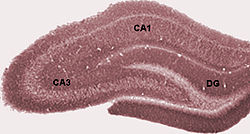
Back تلفيف مسنن Arabic Gyrus dentatus German Giro dentado Spanish Gyrus denté French Giro dentato Italian Gyrus dentatus Dutch Zakręt zębaty Polish Зубчатая извилина Russian Gyrus dentatus Swedish Зубчаста звивина Ukrainian
| Dentate gyrus | |
|---|---|
 Diagram of hippocampal regions. DG: Dentate gyrus. | |
 Coronal section of brain immediately in front of pons. (Label for "Gyrus dentatus" is at bottom center.) | |
| Details | |
| Part of | Temporal lobe |
| Artery | Posterior cerebral Anterior choroidal |
| Identifiers | |
| Latin | gyrus dentatus |
| MeSH | D018891 |
| NeuroNames | 179 |
| NeuroLex ID | birnlex_1178 |
| TA98 | A14.1.09.237 A14.1.09.339 |
| TA2 | 5521 |
| FMA | 61922 |
| Anatomical terms of neuroanatomy | |
The dentate gyrus (DG) is part of the hippocampal formation in the temporal lobe of the brain, which also includes the hippocampus and the subiculum. The dentate gyrus is part of the hippocampal trisynaptic circuit and is thought to contribute to the formation of new episodic memories,[1][2] the spontaneous exploration of novel environments[2] and other functions.[3]
It is notable as being one of a select few brain structures which may have significant rates of adult neurogenesis in many species of mammals, from rodents to primates.[4] Other sites of adult neurogenesis may include the subventricular zone, the striatum[5] and the cerebellum.[6] However, whether significant neurogenesis exists in the adult human dentate gyrus has been a matter of debate.[7][8][9][10][11]
- ^ Cite error: The named reference
pmid17765709was invoked but never defined (see the help page). - ^ a b Saab BJ, Georgiou J, Nath A, Lee FJ, Wang M, Michalon A, Liu F, Mansuy IM, Roder JC (2009). "NCS-1 in the dentate gyrus promotes exploration, synaptic plasticity, and rapid acquisition of spatial memory". Neuron. 63 (5): 643–56. doi:10.1016/j.neuron.2009.08.014. PMID 19755107. S2CID 5321020.
- ^ Scharfman, Helen E., ed. (2011). The Dentate Gyrus: A Comprehensive Guide to Structure, Function, and Clinical Implications. Elsevier. ISBN 978-0-08-055175-3.[page needed]
- ^ Cameron HA, McKay RD (July 2001). "Adult neurogenesis produces a large pool of new granule cells in the dentate gyrus". J. Comp. Neurol. 435 (4): 406–17. doi:10.1002/cne.1040. PMID 11406822. S2CID 15254735.
- ^ Ernst, A; Alkass, K; Bernard, S; Salehpour, M; Perl, S; Tisdale, J; Possnert, G; Druid, H; Frisén, J (27 February 2014). "Neurogenesis in the striatum of the adult human brain". Cell. 156 (5): 1072–83. doi:10.1016/j.cell.2014.01.044. PMID 24561062.
- ^ Ponti G, Peretto P, Bonfanti L (2008). "Genesis of neuronal and glial progenitors in the cerebellar cortex of peripuberal and adult rabbits". PLOS ONE. 3 (6): e2366. Bibcode:2008PLoSO...3.2366P. doi:10.1371/journal.pone.0002366. PMC 2396292. PMID 18523645.
- ^ Sorrells SF, Paredes MF, Cebrian-Silla A, Sandoval K, Qi D, Kelley KW, et al. (March 2018). "Human hippocampal neurogenesis drops sharply in children to undetectable levels in adults". Nature. 555 (7696): 377–381. Bibcode:2018Natur.555..377S. doi:10.1038/nature25975. PMC 6179355. PMID 29513649.
- ^ Boldrini M, Fulmore CA, Tartt AN, Simeon LR, Pavlova I, Poposka V, et al. (April 2018). "Human Hippocampal Neurogenesis Persists throughout Aging". Cell Stem Cell. 22 (4): 589–599.e5. doi:10.1016/j.stem.2018.03.015. PMC 5957089. PMID 29625071.
- ^ Abbott, Louise C.; Nigussie, Fikru (January 2020). "Adult neurogenesis in the mammalian dentate gyrus". Anatomia, Histologia, Embryologia. 49 (1): 3–16. doi:10.1111/ahe.12496. PMID 31568602. S2CID 203622372.
- ^ Cite error: The named reference
Tuncdemirwas invoked but never defined (see the help page). - ^ Zhou, Yi; Su, Yijing; Li, Shiying; Kennedy, Benjamin C.; Zhang, Daniel Y.; Bond, Allison M.; Sun, Yusha; Jacob, Fadi; Lu, Lu; Hu, Peng; Viaene, Angela N.; Helbig, Ingo; Kessler, Sudha K.; Lucas, Timothy; Salinas, Ryan D. (July 2022). "Molecular landscapes of human hippocampal immature neurons across lifespan". Nature. 607 (7919): 527–533. doi:10.1038/s41586-022-04912-w. ISSN 1476-4687. PMC 9316413. PMID 35794479.
© MMXXIII Rich X Search. We shall prevail. All rights reserved. Rich X Search